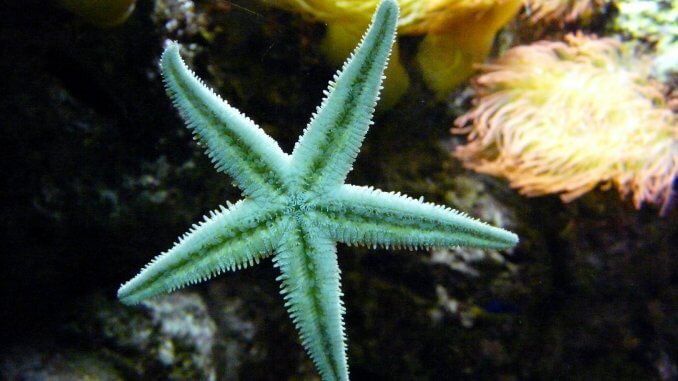
Starfish are found in oceans across the world, including the Arctic and the Antarctic. However, it is the Pacific region that has the most diverse number.
There are roughly 2,000 species worldwide and they come in a huge range of colors, shapes, and sizes.
These fascinating creatures are very different to other aquatic animals such as fish, in the way that they move, eat and regenerate themselves.
Despite having no brain or bones, they have plenty of other incredible characteristics; including complex nervous systems, being able to see with their arms (each arm has an eye spot which is sensitive to light), and also their ability to expel their stomach which they use to wrap around their prey and digest it.
This article is going to look at what starfish eat in the ocean, how they eat, and how to replicate their diet in an aquarium.
TABLE OF CONTENTS
Starfish Facts & Overview
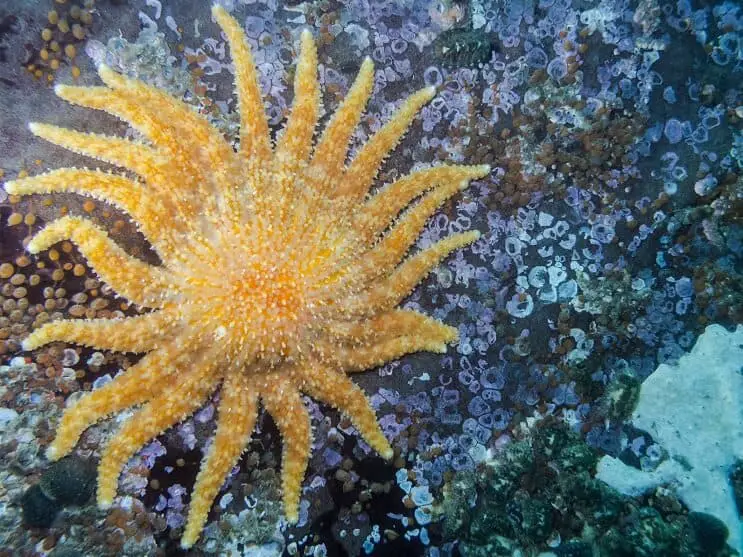
Starfish belong to a large group of marine only animals called Echinoderms. There are many characteristics of animals within the phylum Echinodermata, a few of these characteristics include radial symmetry (symmetrical limbs around one central point), a flat body, and an absent head and tube feet.
There are around 7,000 species of Echinoderms, which include brittle stars, sea urchins, sand dollars, sea cucumbers, crinoids, as well as starfish.
Whilst they are commonly known as starfish, some people are calling for a name change to sea star (as they are commonly known throughout many European counties).
This is because star ‘fish’ are not actually fish. They may live in water like fish, but that is where the similarities end. They do not have scales, fins, or gills, their bodies use sea water instead of blood to circulate the nutrients, and they also use tiny tube feet to move around which sit underneath their bodies.
Some have up to 15,000 tube feet which allow them to move at speeds of two-three meters every minute, which is exceptionally fast for an Echinoderm.
Sea stars belong to the class Asteroidea which derived from the Greek words ‘aster’, meaning star, and ‘eidos’, meaning form, likeness, or appearance. There are around 2,000 species of them spread out over the groups, all of which are marine animals; meaning they live solely in saltwater not freshwater.
Most of them have 5 radial symmetrical arms (identical arms that grow around one central point); however there are species with 10, 20, and even 40 arms. They are famous for their unique ability to regrow arms when they have been damaged and they can intentionally shed limbs if they are in danger, which is known as autotomy.
There have also been studies to show them intentionally getting rid of some of their legs when they have been subjected to high temperatures for too long.
Depending on the species, they grow between 4.7-9.4 inches and can weigh up to 11lbs. They live anywhere between 5 and 35 years.
What do Starfish Eat in the Ocean?
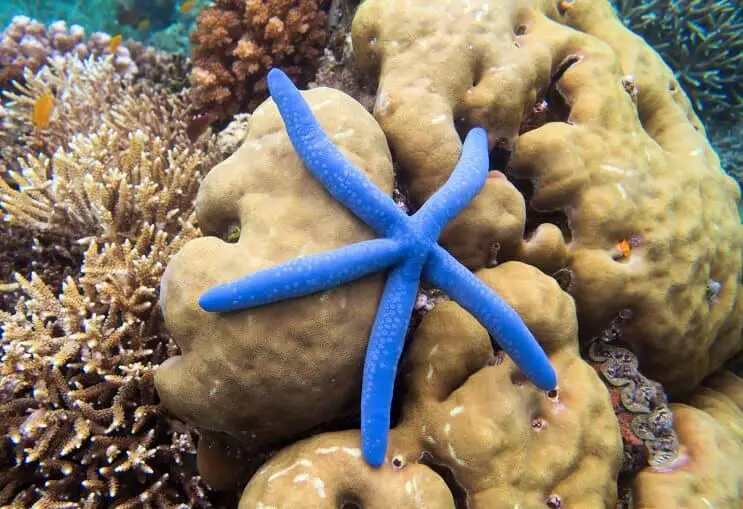
The food that starfish eat very much depends on the species. Some are scavengers, some are predators and some have a similar diet to fish.
The majority of them are carnivorous predators and feed on mollusks such as clams, mussels, and oysters which live on the sea floor. In the wild, one sea star can eat over 50 small clams in a week.
Mollusks are easy for them to find and eat because they are slow moving and usually attached to rocks and other surfaces. They will also eat small fish and some species eat detritus, decomposed plants, and algae.
Here is a list of things that they typically eat in the ocean:
- Barnacles
- Coral Polyps*
- Clams
- Decomposed organic materials*
- Hermit crabs*
- Mussels
- Other starfish*
- Oysters
- Plankton
- Sea snails
- Sea urchins
- Seaweed*
- Slow moving fish
- Snails
*Only some species eat these things.
How do Starfish Eat?
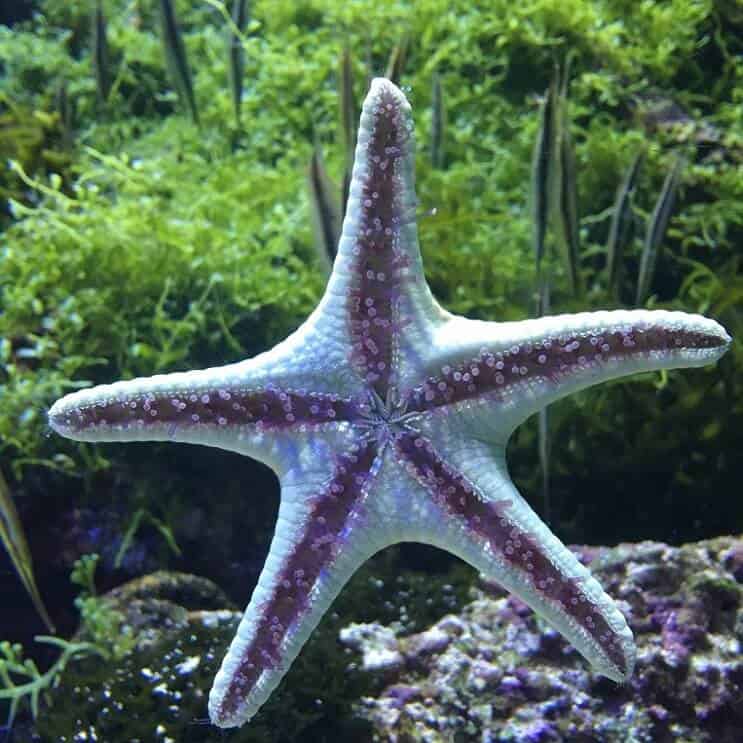
You maybe wondering how exactly starfish eat, with no visible or obvious mouth.
As mentioned earlier, they have eye spots on each arm which are sensitive to light, and their mouth and stomach are on the underside of their body. Their arms allow them to feel around for food.
A large part of how they eat depends on how they move, because without movement they wouldn’t be able to travel around to search for food. So we’ll take a quick look at how they actually move first.
Underneath their arms, they have thousands of tube-like feet which are specially adapted to stick and unstick to things. Here is a video of how a starfish moves.
As well as using their arms to move and hold onto rocks etc, they also use them to hold onto their prey and pull shells apart (a gap of only 0.1mm is needed for them to eat the mollusk).
They digest their food in two stomachs; the cardiac stomach and the pyloric stomach.
To eat their food, they will first center their pray using their arms and tubed feet. When the prey becomes close enough, they extend their cardiac stomach out of its mouth. While it is extended, the stomach looks like a cloud. They then cover their prey with their stomach and partially digest.
If they are eating a mollusk, they use their arms to open shells very slightly, and they then spit their stomachs into the shell. The stomach then releases a chemical that dissolves the mussel, and they absorb the mollusk’s body.
Once they have absorbed their food, it draws the cardiac stomach back into the body, where the digestion of the food continues in the pyloric stomach.
This allows them to eat things which are much larger than them, by digesting them outside of their smaller mouth and bringing them in once it’s been turned to liquid.
Researchers have discovered a molecule that carries signals which triggers the stomach to contract and retract. This research is useful for both economic and environmental reasons. Some will feed on shellfish that are harvested for our food, and other species destroy parts of the pacific reef when there are large surges in population.
This research could therefore allow researchers to chemically control starfish feeding in the wild.
This incredible video shows how a Sunflower Starfish pushes its stomach out to eat a clam.
What do Starfish Eat in Aquariums?
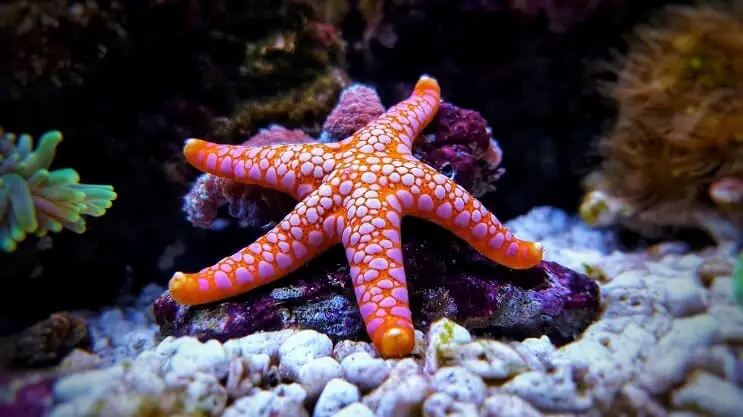
Let us preface this section by saying, that as beautiful as starfish are – they are definitely not for beginners.
They require a lot of care and attention, and need a large tank set up (at least 100 gallons). Many will starve in tanks that are too small with not enough rock. Always make sure you choose the right size aquarium.
Before buying, always thoroughly research the species you are getting. Sometimes fish stores can use incorrect names and sell you the wrong species. Some species are voracious carnivores and will very quickly eat their way through the invertebrates of your reef tank!
As always, to help fish feel comfortable in their environment, and therefore allow them to eat properly without being stressed, it’s vital that you replicate their natural environment as well as possible.
Some live in coral reefs; others live in rocky shorelines, sandy, tidal pools or seagrass meadows. Your aquarium should replicate whichever environment your particular species is used to.
Unsurprisingly, they are really popular in aquariums; however they can’t just be fed fish flakes alone, like most of your other fish.
As we mentioned before, they are grazers and eat food which has fallen to the bottom of your tank, including fish flakes, pellets, and any other food.
Most species enjoy a meaty diet of mollusks, so putting a few clams or mussels in your tank is a sure way to keep them happy.
If you’re buying them from the supermarket, make sure you rinse them thoroughly before adding them to the tank.
Similarly to other algae eaters, they’ll also eat the algae in your tank as well as frozen shrimps, prawns and sponges (ideally not frozen sponges).
Some species will accept vegetables such as boiled spinach, kale and other greens. You might want to make your own fish food to ensure they are getting the best diet possible.
The frequency of feeding depends on the species; you’ll be able to determine this by watching how often they eat.
Usually they need to be fed every 2-3 days. It’s easy enough to see if your starfish is hungry – place a piece of food beside them and it will quickly eat it if its hungry.
If you’re worried about your fish eating the food before the starfish, place the starfish directly on top of the food when you place it in the bottom of the tank.
Whilst they as usually nocturnal, they will quickly adapt to daytime feeds after being exposed to them often enough.
It’s really important to thoroughly research the species before you add it to your tank. Some species such as Chocolate Chip eat corals; others are not as destructive but still require a diet which a lot of hobbyists are unable to provide.
Here is a brief table detailing what each species of popular aquarium starfish eat.
| Common Name | Diet | Details |
|---|---|---|
| Chocolate Chip Starfish (Protoreaster nodosus) | Chopped clams, shrimp and squid. They will eat soft corals, sponges, and tubeworms. | Cannot be kept with corals. They look like chocolate chip biscuits. |
| Marble Sea Starfish/Tile Sea Star (Fromia monilis) | Include plenty of live rock as they forage for micro-organisms and detritus. Supplement its diet with small pieces of shrimp, and flaked food. | One of the more common Fromiaspecies. Highly active and enjoy complex environments. Thrive on live rock. |
| Sand Sifting Starfish (Astropecten polycanthus) | Needs to be directly fed a variety of foods on the sand bed, such as shrimp, urchins and mollusks. Will very quickly clear out detritus and left-over food and can starve if not supplemented. | Reef safe. Plain beige appearance but useful in sifting through sand. |
| Linckia Starfish (Linckia laevigata) | When introduced to well-established aquarium, little needs to be done to supplement diet. If it does need to be supplemented, place small clam meet or tablets underneath them. | Reef safe. Although they can grow large, they are relatively easy to care for. Come in a huge range of bright colors. |
As we’ve mentioned, it’s important to feed your starfish based on the particular species. Their main diet will be based on the food they usually eat in the wild, for some this will be meaty foods, for other this will be algae.
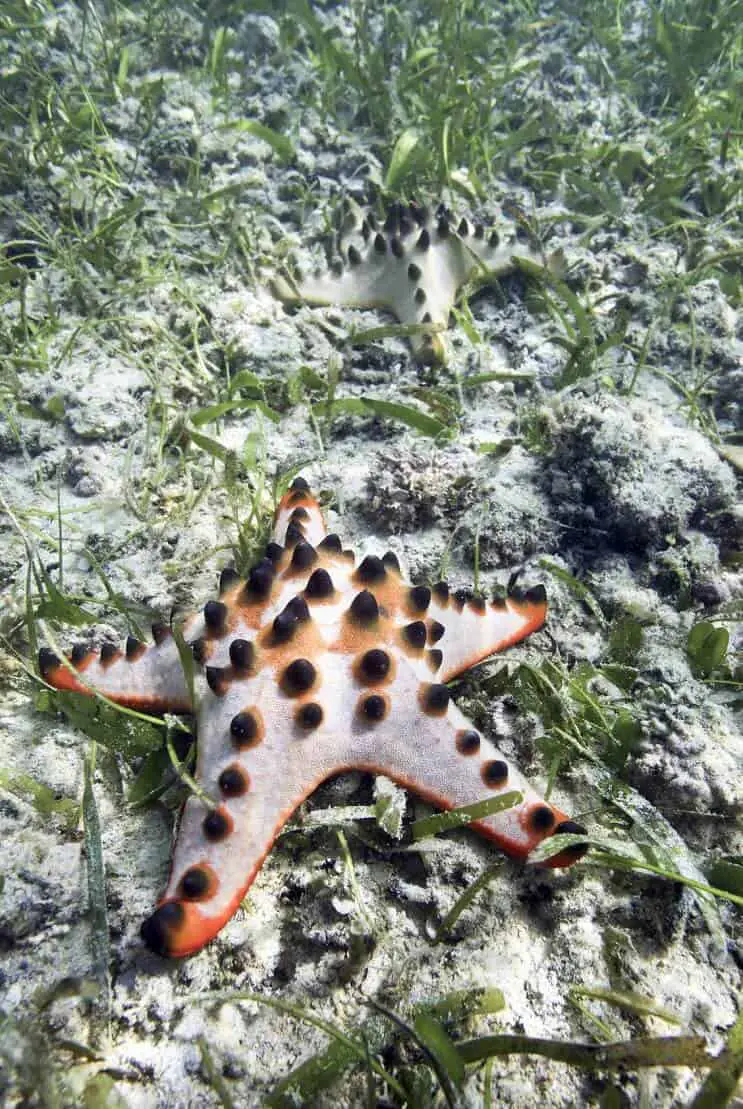
Summary
If you’re an experienced fish keeper, looking for a unique and extremely interesting new inhabitant for your saltwater tank, the starfish might just be for you.
Some species are quite simple to feed, others are more difficult. As always, make sure you research the species you want to introduce to your tank to ensure you get species specific feeding advice.
It is unfortunately all too common for them to die in captivity either due to poor water conditions, not surviving the acclimatization, or starving to death.
If you are sure you want to include one in your tank, make sure you know exactly how to care for it, how to keep the tank clean, and the right diet to provide it with.
Which starfish are you thinking of getting? Is there a particular one you like the look of? Let us know in the comments below, we love hearing from you…

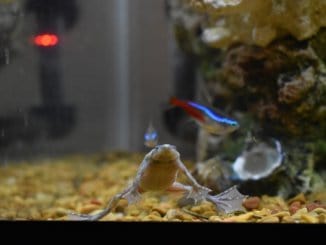
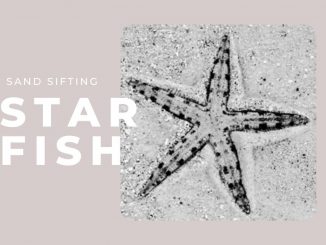
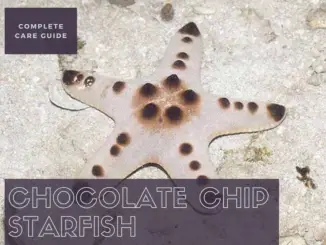
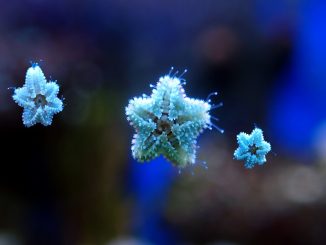
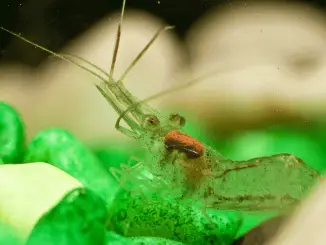
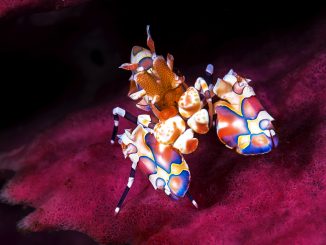
Hello! I’m thinking of getting a bat starfish. Would a 15 gallon tank be enough for just one starfish?
Hi, I have a little icon star fish. (about 1.5 inches) I bought because the local store said it would be fine in my 13.5 gal tank. I can find very little information about them, although have since found out my tank is much too small. I have had it for 7 months and it is still healthy. About 1 a month it will take a pellet of food. I am not sure what it’s main source of nutrition is. If you know a good source of information could you reply. Thank you so much for your wonderful site.
I have had my star for just over 15 years and he is in a 250 Ltr reef. He just started eating some of my corals and I was considering moving him to a small tank but your article has made me rethink! Thank you.